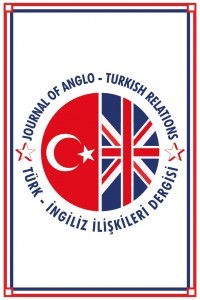Portraits from War to Peace: Britain and Turkey (1914-1939)
The purpose of this article is threefold. One is to address an age-old foreign policy framework that shaped Anglo-Turkish relations prior to and in the aftermath of World War I (WWI). Namely, how the Eastern Question came to bear on the ideational level and in practice in Anglo-Ottoman/Turkish relations. Secondly, punitive peace conditions were imposed on the Central Powers under the unprecedented demand for unconditional surrender. Victors did not take into consideration the possibility of resistance, let alone armed resistance from the defunct Ottoman Empire whose core territories, including its capital were under Allied occupation. A state of war continued until a negotiated peace was concluded in 1924. Peace-making was formalized in 1920, but mainly in terms dictated by the Allies. Hence, a state of war continued until resistance prevailed in 1924. The third aspect of the saga was peacebuilding. European conjuncture of the 1930s forced London and Ankara, by then the capital of the Republic of Turkey, to mend fences albeit reluctantly for the former, but facilitated by diplomats. Consequently, inspired by the English poet Alexander Pope that “the proper study of mankind is man,” this article analyses the politics of war, its aftermath, peace-making, and peacebuilding through portraits of public influencers, decision makers and diplomats who were practitioners of policy. Inherent during this timeframe is how assumptions about their political future resonated on their Turkish interlocutors.
Anahtar Kelimeler:
Edwin Pears, Percy Loraine, Nathaniel Curzon
Portraits from War to Peace: Britain and Turkey (1914-1939)
The purpose of this article is threefold. One is to address an age-old foreign policy framework that shaped Anglo-Turkish relations prior to and in the aftermath of World War I (WWI). Namely, how the Eastern Question came to bear on the ideational level and in practice in Anglo-Ottoman/Turkish relations. Secondly, punitive peace conditions were imposed on the Central Powers under the unprecedented demand for unconditional surrender. Victors did not take into consideration the possibility of resistance, let alone armed resistance from the defunct Ottoman Empire whose core territories, including its capital were under Allied occupation. A state of war continued until a negotiated peace was concluded in 1924. Peace-making was formalized in 1920, but mainly in terms dictated by the Allies. Hence, a state of war continued until resistance prevailed in 1924. The third aspect of the saga was peacebuilding. European conjuncture of the 1930s forced London and Ankara, by then the capital of the Republic of Turkey, to mend fences albeit reluctantly for the former, but facilitated by diplomats. Consequently, inspired by the English poet Alexander Pope that “the proper study of mankind is man,” this article analyses the politics of war, its aftermath, peace-making, and peacebuilding through portraits of public influencers, decision makers and diplomats who were practitioners of policy. Inherent during this timeframe is how assumptions about their political future resonated on their Turkish interlocutors.
Keywords:
Percy Loraine, Nathaniel Curzon Peace-making, Peacebuilding, Edwin Pears,
___
- Yosmaoğlu, İpek. Blood Ties: Religion, Violence, and the Politics of Nationhood in Ottoman Macedonia, 1878-1908, (Ithaca and London: Cornell University Press, 2014).
- Waterfield, Gordon. Professional Diplomat, Sir Percy Loraine, 1880-1961, (London: John Murray, 1973).
- Ortaylı, İlber. Osmanlı İmparatorluğu’nda Alman Nüfuzu, (İstanbul: Kronik Kitap, 2018).
- Berridge, Geoffrey. British Diplomacy in Turkey, 1583 to the Present: A study in the evolution of the resident embassy, (Leiden and Boston: Martinus Nijhoff Publishers, 2009).
- Başlangıç: 2020
- Yayıncı: Behçet Kemal YEŞİLBURSA
Sayıdaki Diğer Makaleler
Interview with Fethiye International Group (FIG)
Can the British Garden City Model be a Solution for Post-Pandemic Ankara?
Kıbrıs’ta Radyoculuk ve Radyocu Kadınlar (1939-1963)
Portraits from War to Peace: Britain and Turkey (1914-1939)
Business as Usual? The Present and Future Impact of Brexit on Anglo-Turkish Relations
Görkem ALTINÖRS, Yaprak GÜRSOY
Turkish Foreign policy, state identity and elites: Continuity and Transformation
The Impacts of Lausanne Treaty on British Colonialism
Interview with the cinema and theatre actress, Suna Yıldızoğlu (Istanbul, 9 June 2021)
